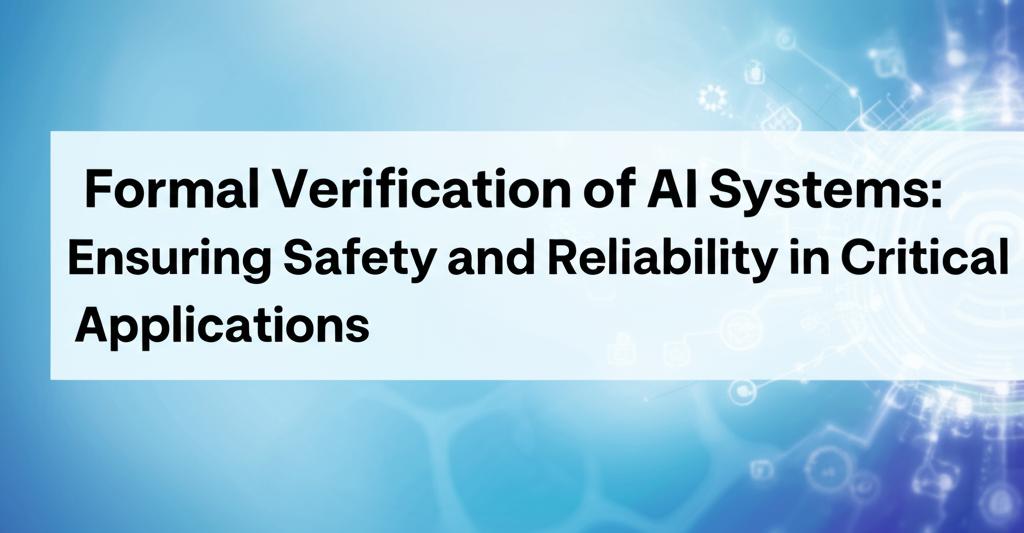Artificial intelligence (AI) is increasingly being deployed in critical systems where failures can have severe consequences, including financial loss, physical harm, or even loss of life. Applications in autonomous driving, medical diagnosis, aerospace, and financial trading demand the highest levels of safety and reliability. While traditional software verification techniques are well-established, the unique characteristics of AI systems, particularly those based on machine learning (ML), present new and significant challenges. Formal verification offers a rigorous mathematical approach to prove or disprove the correctness of a system's behavior with respect to a given specification, providing a much-needed layer of assurance for these advanced technologies.
The Unique Challenge of Verifying AIAI systems, especially those utilizing deep learning, often operate as "black boxes." Their decision-making processes can be incredibly complex and opaque, making it difficult to predict or explain their behavior in all possible scenarios. Unlike traditional software, where logic is explicitly programmed, ML models learn from data. This data-driven nature means that the behavior of the AI can be sensitive to the quality and distribution of the training data, and it might exhibit unexpected behavior when encountering novel inputs (out-of-distribution data).
Key challenges in formally verifying AI include:
- Scale and Complexity: Modern neural networks can have millions or even billions of parameters, making exhaustive analysis computationally infeasible.
- Non-determinism: Some AI algorithms incorporate randomness, further complicating verification.
- Defining Properties: Specifying the desired correct behavior (the "what" to verify) for complex AI tasks can be non-trivial. For instance, how do you formally define "safe driving" for an autonomous vehicle in all conceivable situations?
- Reachability Analysis: Determining the set of all possible outputs or states an AI system can reach given a range of inputs is a core problem, and it's incredibly hard for complex models.
- Robustness to Perturbations: AI models can be vulnerable to adversarial attacks—small, often imperceptible, changes to inputs that cause the model to misclassify or behave erratically. Verifying robustness against such attacks is crucial.
Despite the challenges, significant progress is being made in developing techniques for the formal verification of AI systems. These approaches often focus on specific properties or types of AI models:
- Model Abstraction: This involves creating a simpler, more abstract representation of the complex AI model. Verification is then performed on this abstraction. If a property holds for the abstraction, it might also hold for the original model, or it can help identify areas needing closer scrutiny. Techniques like abstract interpretation are used here.
- Satisfiability Modulo Theories (SMT) Solvers & Mixed Integer Linear Programming (MILP): For certain types of neural networks (e.g., those with piecewise linear activation functions like ReLU), their behavior can be encoded as SMT or MILP problems. These solvers can then be used to check if certain undesirable states (e.g., a misclassification leading to a safety violation) are reachable.
- Reachability Analysis for Neural Networks: Tools are being developed to compute or over-approximate the set of all possible outputs of a neural network given a defined set of inputs. This helps in verifying safety properties, such as ensuring that an autonomous vehicle's control output stays within safe bounds.
- Verification of Robustness: Specific methods aim to prove that for a given input and a defined neighborhood around it (e.g., small pixel changes in an image), the AI model's output remains consistent or within an acceptable range. This is vital for defending against adversarial attacks.
- Verifying Reinforcement Learning (RL) Systems: RL agents learn by interacting with an environment. Verifying their policies to ensure they don't learn unsafe behaviors is an active area of research, often involving model checking techniques adapted for probabilistic and learning-based systems.
- Hybrid Approaches: Combining formal methods with extensive testing and simulation can provide a more comprehensive assurance strategy. Formal methods can guide the testing process to focus on critical or hard-to-reach scenarios.
The need for formal verification is most pressing in domains where AI failures are intolerable:
- Autonomous Vehicles: Ensuring that perception systems correctly identify objects, and that decision-making algorithms always choose safe maneuvers, is paramount. Formal methods can help verify properties like "the vehicle will always maintain a safe distance from the car in front."
- Healthcare: AI is used for medical image analysis, disease diagnosis, and treatment recommendations. Verification can help ensure that diagnostic AI doesn't miss critical conditions or that AI-controlled medical devices operate safely.
- Aerospace and Defense: From autonomous drones to an AI co-pilot system, the safety and reliability requirements are exceptionally high. Formal verification can help guarantee predictable behavior in high-stakes environments.
- Financial Systems: Algorithmic trading systems and fraud detection AIs need to be robust and reliable to prevent massive financial losses or unfair outcomes.
- Robotics: For collaborative robots working alongside humans or robots operating in hazardous environments, formal verification can ensure safe interactions and mission completion.
While formal verification of AI is still a developing field, its importance is undeniable. Future progress will likely involve:
- More Scalable Techniques: Developing methods that can handle larger and more complex AI models.
- Compositional Verification: Breaking down large AI systems into smaller, verifiable components and then reasoning about the entire system's properties based on its components.
- Standardization and Tooling: Creating standardized benchmarks, property specification languages, and more mature, user-friendly verification tools.
- Integrating Verification into the AI Development Lifecycle: Shifting from post-hoc verification to incorporating formal methods throughout the design and training phases of AI systems.
- Explainability and Interpretability: Formal methods can also contribute to understanding why an AI model makes a particular decision, which complements the goal of ensuring correct behavior.
Adopting formal verification for AI systems in critical applications is not just a technical challenge but a necessary step towards building trustworthy AI. As AI becomes more integrated into the fabric of society, mathematically rigorous assurance of its safety and reliability will become an indispensable requirement, fostering public confidence and enabling the responsible deployment of these powerful technologies.

